The Saru River Basin Depicted in ‘Unbeaten Tracks in Japan’ (Commentaries)
Read about the Saru River Basin where Isabella Bird used to travel !
What the book ‘Unbeaten Tracks in Japan’ depicted are the appearance of the relationship between the nature of Hokkaido and the nature of Ainu people in the early Meiji era through the eyes of Bird. In the present Hokkaido, a considerable ‘original’ natural landscape are still available and can be read from the travel of Bird.
●From Tomakomai to Sarufuto (Tomikawa)
Tomakomai is a town with a division point leading to Sapporo via the ‘Sapporo Main Road’ and Erimo. “At this place the road and telegraph wires turn inland to Satsuporo, and a track for horses only turns to the north-east…”. “I was happy when I left the “beaten track” to Satsuporo”, this depicted place is also part of Tomakomai today.
Then, she depicted what she saw before her with words filled with openness, “stretching for I know not how far, rolling, sandy machirs like those of the Outer Hebrides, desert-like and lonely, covered almost altogether with dwarf roses and campanulas, a prairie land on which you can make any tracks you please.”
After travelled eight miles from Tomakomai, she arrived at Yubets (currently known as Yufutsu). It is a place which she depicted as “It looks like the end of all things, as if loneliness and desolation could go no farther,” but maybe because of the loneliness and desolation, she surprisingly said: “I intend to return to it.”
From Yufutsu, Bird went on an enjoyable trip on a horse via a comfortable road for 17 miles. Then, she had to ford one broad and deep river, and crossed another river by canoe and fording. Before long, flat road became steep and she also had to pass through a mixed forest, and “emerged upon an Aino hut and a beautiful placid river.” That river seems to be part of Saru River. There, Bird had to go upstream from Sarufuto village (currently known as Tomikawa of Hidaka Town) through the river terrace to Biratori and again crossed the Saru River. It was because the downstream area of Saru River was broad wetland area, hence, difficult to pass through. Bird was also boarded an Ainu’s flat bottom canoe to cross the river. However, she did not record the name of the river which allowed her to arrive at Sarufuto village.
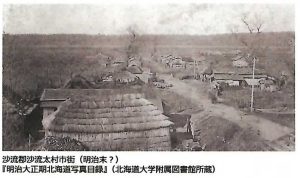
● From Sarufuto (Tomikawa) to the Destination, Biratori.
Sarufuto village was a place pioneered by a clan from Sendai. About 12 miles from here, at the back of a mountain, was an Ainu village which Bird was aiming to go. Here was also a place she met Mr. Von Siebold again and was introduced to Benri, the chief of Ainu village in Biratori. After Bird got his permission to stay at his village, she went directly to Biratori.
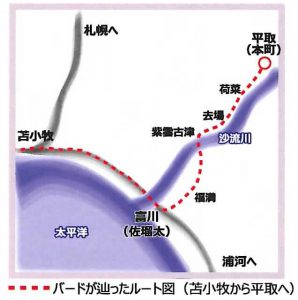
Until Biratori, it was still “a beaten track the whole way.” It then turns into a desire path where “the forest is dark and very silent, threaded by this narrow path, and by others as narrow, made by the hunters in search of game”, arrived at Shiri River (currently a tributary of Saru River) and crossed to the other side of Saru River in a small canoe. Currently, there is an information board about the ‘Path Isabella Bird Took’ at Shiunkotsu Kawamukai Bridge which was launched in 2009 (Heisei 21) near to the boarding area.
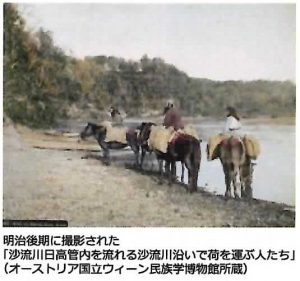
Bird had been surprising to see how Ainu village was carefully maintained during her journey. And she arrived at a destination she had always wanted to go, the largest Ainu village in Biratori. She also stayed together with the Ainu people for a few days at the Chief Benri house near to the Yoshitsune Shrine.
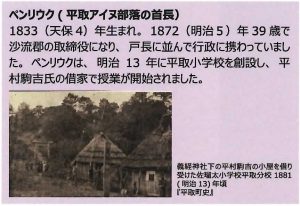
“Biratori, the largest of the Aino settlements in this region, is very prettily situated among forests and mountains, on rising ground, with a very sinuous river winding at its feet and a wooded height above.”
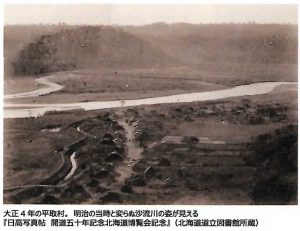
In spite of a short stay, she surveyed vigorously about the affectionate life, customs, religion and etc of Ainu people and left behind valuable findings of their life at that time. In addition, as a token of appreciation for nursing a sick patient, she was guided to Yoshitsune Shrine, which had never been visited by any foreigner other than Ainu people themselves.